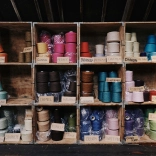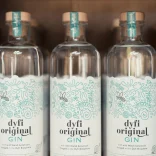It's a tall order to choose just a handful of items to represent a nation. The seven institutions that make up National Museum Wales have many thousands of artifacts that could make the cut, from great Impressionist paintings at National Museum Cardiff to an entire workmen's institute transferred brick by brick to St Fagans National Museum of History. Nevertheless, here's our choice of 10 items to symbolise the culture and character of Wales.

The Red Book of Hergest (Llyfr Coch Hergest)
Although it’s named after a place in England – Hergest Court in Herefordshire, where it sat out the Elizabethan Age – the Red Book is the most important medieval manuscript in the Welsh language. It’s best known for containing the Mabinogion, a collection of the earliest Welsh prose. Its stories introduce a rich cast of characters, including many strong women. There's the flower maiden Blodeuwedd (eventually turned into an owl for betraying her husband, Lleu Llaw Gyffes), the expert horsewoman Rhiannon, and Branwen, the princess whose unhappy marriage destroys two nations. By the time a scribe had painstakingly written the tales out at the end of the 14th century, they would already have been centuries old; but their themes of murder, heartbreak, ambition and loss are timeless.

Raspberry Pi
In July 2017, the 10 millionth Raspberry Pi emerged from its production facility at Pencoed, near Bridgend. The inexpensive, credit-card-sized unit is now the best-selling British-designed computer of all time (and out of all computers worldwide, third only to the Apple Mac and the mighty PC). The Pi was originally manufactured in China, until founder Eben Upton moved production to Pencoed’s Sony UK Technology Centre in 2012, praising its “unparalleled manufacturing standards”.

The Coal Exchange tide clocks
Cardiff was among the world’s most important ports in the early 20th century, and the Coal Exchange was its beating heart. The entrance hall featured two wooden lions on pillars, each guarding a clock set to the city’s high-water times in the morning and the afternoon – essential information for the traders on the market floor. The intricately carved clocks are testament to a time when the world was governed by Cardiff time and tides.

The Nanteos Cup (Cwpan Nanteos)
Is the Holy Grail hiding in plain sight in Aberystwyth? Now on permanent display at the National Library of Wales, the Nanteos Cup was once credited with supernatural healing powers. Devotees in rural Ceredigion claimed it to be a relic made from wood of the True Cross, hidden for centuries in Strata Florida Abbey. Somewhat inconveniently, analysis now shows it to be a food bowl made from native elm, some 1,400 years after the birth of Jesus. But the legend has proved remarkably hardy, with many headlines about “the hunt for the Holy Grail” when it was stolen (and soon recovered) in 2014.

A leek – or a daffodil?
There’s no denying the beauty of a vase of daffodils, while the leek is featured less often in still-life paintings. But when it comes to Welsh symbols, the flower is something of an interloper. It was gradually adopted as an alternative symbol because its Welsh name – cenhinen pedr, or “Peter’s leek” – led to confusion with the older emblem.

Cambriae Typus
Wales may be seen on earlier maps, but the Cambriae Typus of 1573 was the first one to show it as a nation distinct from the rest of Britain. It was the handiwork of Humphrey Llwyd, a scholar, collector and politician from Denbigh. Today, it would be ill-advised to use as a sat-nav replacement: the many errors on the map include the complete erasure of the Gower Peninsula. But with place names recorded in Welsh, English and Latin, it’s an invaluable record of Renaissance Wales.

The Felinfoel beer can
Beer in a tin can? Commonplace today, but unknown to Britain back in 1935. It was first manufactured that year at the Felinfoel Brewery in Llanelli, whose owners were tin magnates as well as brewers. They came up with the idea of coating the inside of a can with an inert wax to stop the beer inside getting a metallic tang. It proved a hit with drinkers, and didn’t do any harm to South Wales’ domination of the tin industry: in 1945, the region still had more than 300 tinplate mills in operation.

A cnapan ball
If you think rugby is a physical game, try cnapan. First recorded in the ninth-century History of the Britons by the Welsh monk Nennius, it involved the entire male population of two villages fighting to steal a hard wooden ball and carry it home. To add extra interest, the ball could be boiled overnight in fat to make it extra-slippery. Though violent and chaotic, it’s considered the ancestor of modern football and rugby – and some even think it contained primitive versions of the scrum and line-out.

Jemima Fawr’s memorial
The 1797 Battle of Fishguard was the last time an invading army landed on British soil. After coming ashore near the Pembrokeshire town, the rag-tag French forces started looting farmhouses and got drunk on stolen wine. Jemima Nicholas, a 47-year-old cobbler’s wife, went out into the fields with a pitchfork and single-handedly rounded up 12 of the soldiers, locking them in a church until they surrendered. It earned her the nickname of Jemima Fawr – “Great Jemima” – and a memorial stone at St Mary’s Church in Fishguard.

The fuel cell
When humankind went to the Moon in 1969, a piece of Welsh ingenuity blasted off with the three NASA astronauts. The electric power and drinking water in the Apollo spacecraft were produced by fuel cells, which combine hydrogen and oxygen in a controlled electrochemical reaction. It’s an application first described in 1838 by the Welsh physicist and barrister William Grove, who managed to create a working prototype just three years later.
Further reading: Find another perspective on Welsh heritage – and 10 times more artefacts, one or two of which coincide with our choices – in the book 'Wales in 100 Objects' by Andrew Green.




